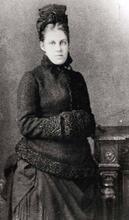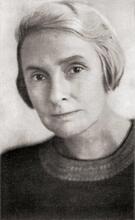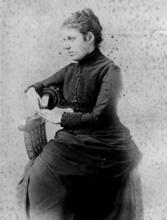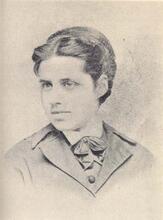Esther Luria
Born in Warsaw, Esther Luria received a doctorate from the University of Bern in 1903 and immigrated to the United States in 1912. A freelance journalist whose work appeared in many politically left-of-center Yiddish publications in the early twentieth-century United States, she was a socialist, a feminist, a political activist, and an educator. Luria hoped to inspire her women readers by writing about notable Jewish women; in addressing topics of special interest to women, such as women’s low wages and the education of children, she blended class, gender, and cultural issues. Luria used her columns not only to advocate for the ideas in which she believed, but also to provide her mainly east European immigrant readers with a better understanding of their new environment.
Esther Luria was a freelance journalist whose work appeared in many politically left-of-center Yiddish publications in the United States in the opening decades of the twentieth century. A socialist, a feminist, and a political activist, Luria was also, perhaps even more so, an educator. She used her columns not only to advocate for the ideas in which she believed, but also to provide her mainly east European immigrant readers with a better understanding of their new environment. Luria urged her readers to enter American life as fully as possible and provided information and encouragement to help them do so.
Early Life and Education
Luria was born in Warsaw, Poland, in 1877. She completed a gymnasium (high school) education and then traveled to Switzerland, one of the few places women could pursue graduate studies. In 1903, at the age of 26, she was awarded the degree of Doctor of Humanistic Studies from the University of Bern. While in Switzerland she became active in the growing socialist movement. Returning to Warsaw, she joined the Jewish socialist Bund, was arrested several times for revolutionary activity, and in 1906 was exiled to Siberia. Six years later she escaped and made her way to New York City. In the years that followed she earned a meager living by writing for the Yiddish press, including Tsukunf (Future), Glaykhayt (Justice, the Yiddish edition of the International Ladies Garment Workers Union paper), and the socialist Forvertz (Forward, the most widely read Yiddish paper of its time).
Feminism
A feminist as well as a socialist, Luria hoped to inspire her women readers by writing about notable Jewish women, such as the hostesses of cultural salons in Germany, the poet Emma Lazarus, and the sociologist Martha Wolfenstein. In the spring of 1919, she wrote two series of articles for the women’s page of the Forvertz addressing two topics of special interest to women: women’s low wages and the education of children. Both show her unique blending of class, gender, and cultural issues. Luria began with the usual explanations for women’s low wages: that women worked in unskilled or easily learned trades, that parents favored investing in a son’s education as he would need to support a family, and that many women, expecting to marry, saw their jobs as temporary. She went further however, to stress the impact of gender discrimination. International in her interests, she noted that women in Europe as well as the United States were paid less for doing the same work as men. Gender discrimination crossed class lines, as professional women earned less than professional men.
In her articles, Luria argued that higher wages were necessary for women not only for economic survival, but also to provide opportunities for intellectual and cultural growth. She believed that women should aim not just for higher wages but for wage equality with men. Unlike American reformers who favored special laws to protect women from working in industries that presumably threatened their roles as mothers, Luria looked forward to a time when “there will not be a struggle for women’s wages, only for wages in general” (“Why Do Women Receive Lower Wages than Men” and “Women’s Interests”).
Although still favoring radical ideas such as gender equality, Luria moved from her early support of revolution in Europe to a gradualist position more suitable to American conditions. She urged her readers to work for social change through the political system and the trade union movement.
Views on Education
Luria’s writing on the education of children in the United States combined her socialist ideology with insights from the work of contemporary American psychologists and educators. In articles such as “The Child and The Community,” “The Child and Its Memories,” and “Sympathies Felt by Children,” she transmitted to her immigrant readers her understanding of the work of influential Americans such as John Dewey and G. Stanley Hall, although she does not mention them by name. Drawing on the findings of the then current Child Study Movement, Luria told her readers what activities and interests were appropriate for children of different ages. She warned parents against expecting children to learn things they could neither relate to nor understand. While critics of immigrant families sometimes worried that children were neglected, Luria cautioned parents against too much interference in their children’s lives and urged them to respect their children’s individuality. “One cannot make from a child what one wants. You must look at their inclinations…. Parents and teachers can’t play with a child’s soul, even when they do their best” (“Child as a Person for Itself” and “Women’s Interests”).
Luria offered sympathy and understanding as well as advice to parents having difficulties with their American-born children. However, she disliked the permissiveness and the emphasis on self-expression favored by some progressive educators, seeing these trends as contrary to the development of social responsibility. She believed that children should help at home, according to their age and ability. “The child must learn to consider the parents, brothers, and sisters, and after that the community. Then it will be able to leave home in the future” (“Child as a Person”). Luria was ambivalent about the American public schools, to which most Jewish parents eagerly sent their children. As a socialist she criticized them for being mechanical, for ignoring children’s souls, and for failing to develop “comradely feelings” among the children. At the same time she recognized the importance of the public school for social mobility and urged parents to reinforce what their children learned there.
Practical as well as idealistic about what education could do, Luria informed parents about the new vocational programs offered in the comprehensive high schools and junior high schools and recommended them for children unlikely to go to college. She recognized that Jewish parents did not want their children to enter the sweatshops and work as hard as they did. However, she reminded them that many professionals, including teachers, earned less than skilled factory workers and that “the intelligent proletariat is worthy of respect” (“Additional Education for Children Who have Ended Public School and “Women’s Interests”). Despite her personal allegiance to the working class, Luria pointed the way to white collar occupations for working class adults through public night schools and private business schools. She not only informed her immigrant readers about educational opportunities, she also attacked poverty and old world attitudes that might interfere. “In no country is there greater opportunity than America, where people can study for free” she wrote. “Here one can study and at the same time earn a piece of bread in a shop…. There is no tradition of shame for a student to work” (“Additional Education”).
Influence and Decline of the Yiddish Press
Dr. Esther Luria was important as one of many journalists, women and men, who wrote for foreign language newspapers. These newspapers were an important cultural force. In 1920 the immigrant press had a circulation of between seven and ten million, not including the many copies that were passed from hand to hand or read aloud in the home or workplace. More women were reached by the immigrant press than by settlement houses, “home teachers,” and night schools combined (American Newspaper Annual, p. 7). Luria published regularly in the Forvertz, the largest Yiddish paper in the United States and in the world, giving her socialist and feminist perspectives wide exposure. However, her most lasting impact was her promotion of Americanization. Setting her own class loyalty aside, she wrote articles that helped prepare working-class immigrants and their children for life in the United States and entry into the American middle class.
As journalists like Luria promoted Americanization, ironically they contributed to the demise of the Yiddish culture that had sustained them. When increasing numbers of immigrants and their children learned English, the demand for Yiddish newspapers declined. The ideologies that had nurtured Luria and connected her to her readers also declined. Socialism and trade unions suffered from internal factionalism and fell out of favor in the “Red Scare” aftermath of the Russian Revolution. Feminism seemed less urgent after the passage of women’s suffrage. Disillusionment with World War I fed nativism and made immigrants suspect. Under these conditions, Luria found it increasingly difficult to support herself as a socialist, feminist Yiddish journalist. She tried to earn her living by giving lectures on socialist topics—with little success. She died alone and in poverty in the 1920s. The exact date of her death is not recorded.
American Newspaper Annual and Directory. Philadelphia: N.W. Ayer and Son, 1920, p. 7.
Leksikon fun der Nayer Yiddisher Literature (Lexicon Biographical Dictionary of Modern Yiddish Literature) vol. 4, Congress for Jewish Culture Inc. New York: Marston Press, 1968, pp. 29-30.
Luria, Esther. “Why Do Women Receive Lower Wages than Men” (“Women’s Interests” section). Forward, March 8, 1919.
Luria, Esther. “The Child as a Person for Itself” (“Women’s Interests” section). Forward, May 10, 1919.
Luria, Esther. “Additional Education for Children Who Have Ended Public School” (“Women’s Interests” section). Forward, June 21, 1919.
Park, Robert E. The Immigrant Press and Its Control. New York: Harper and Brothers Publishers, 1922.
Archival Material:
Partially digitalized archives that may hold relevant materials about Luria include those of the Yiddish Book Center, Amherst, MA, and YIVO Institute for Jewish Research at the Center for Jewish History in New York City.
Yiddish newspapers published in New York during the years Luria was writing, available from the New York Public Library, include Forverts, Der Tag (The Day, the second most widely read, after the Forward, liberal and pro Zionist), Die Varhayt (Truth), Yiddish Tageblatt (Jewish Dailey News), and Der Morgan Zshurnal (The Jewish Morning Journal).









